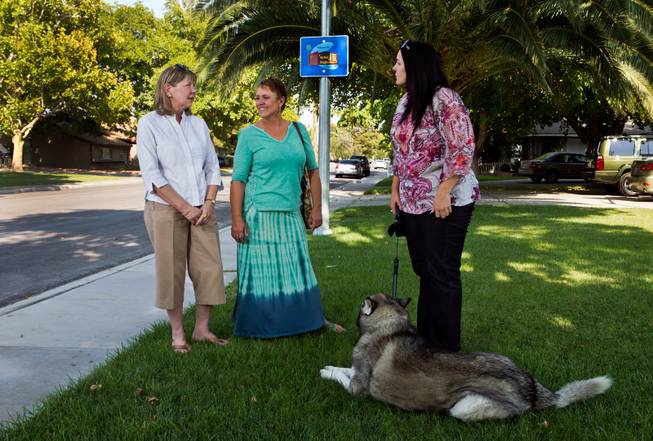
McNeil Neighborhood residents Pat Thacker, Suzan Woodbeck and Shawna Waldman chat about their concerns on the proposed master plan for the nearby medical district, Wednesday, Aug. 19, 2015. Waldman is joined by her dog J.J.
Friday, Aug. 21, 2015 | 2 a.m.
The residents of McNeil Neighborhood, an enclave of well-manicured, spacious ranch-style homes in central Las Vegas, like to pride themselves on their community spirit.
They regularly hold block parties, gather for “coffee on the curb” and maintain a robust Facebook page, where neighbors offer restaurant recommendations, discuss security concerns and give away figs growing on their trees. In December, several dozen residents donated blood during a holiday party, and just last week the neighborhood raised $345 to pay for a stray dog’s medical care.
Suzan Woodbeck, who bought a home here two years ago after attending a party and falling in love with the atmosphere, said, “I’ve always considered Las Vegas a friendly town, but it was so noticeably different. I would have done anything to live in this neighborhood.”
Now the close-knit neighborhood, located just south of Charleston Boulevard near Rancho Drive, has banded together for another cause: They’re rallying against the redevelopment of an adjacent parcel as part of the Las Vegas Medical District, a planned 674-acre cluster of medical offices, retail and residential space that borders their neighborhood.
“We want to remain in line with current zoning,” said Shawna Waldman, who has lived in the neighborhood for 13 years.
At a community meeting earlier this month, city officials showed McNeil residents architectural renderings of potential development. The conceptual images, labeled as a “sample block,” depicted a Whole Foods and Starbucks surrounded by buildings two- or three-stories high with residential space. Currently, the existing buildings rise to only one story.
Residents weren’t happy. They peppered Councilwoman Lois Tarkanian, who represents their ward, with uneasy questions about building heights, noise and traffic.
Street signs embellished with a vintage-looking image say “Welcome to McNeil Neighborhood, Established in 1947,” an ode to when the first house was built. Now filled with 580 homes and many towering trees, the neighborhood has become known for its charm, attracting the occasional film project.
“One of the things that makes McNeil Neighborhood so special is that it’s almost like turning back the clock,” Waldman said. “There’s a very rich history in this neighborhood that deserves to be preserved.”
But that doesn’t mean residents are opposed to the whole of the medical district, the proposed home for the UNLV medical school and an array of other health care businesses.
City leaders estimate the medical district’s economic impact could exceed $3 billion by 2030. Local dignitaries, including Mayor Carolyn Goodman, celebrated the opening of a new Steinberg Diagnostic Medical Imaging center next to the hospitals earlier this month. It was the first brick-and-mortar addition to the medical district, signaling future growth ahead.
A study conducted this summer by Applied Analysis found that 89 percent of residents near the medical district support the initiative. Valleywide, 93 percent of residents said they support it. The survey, conducted in May and June, included 802 respondents, 400 of whom live within the boundary of the medical district, which stretches northeast to Symphony Park and includes a thin section of Charleston Boulevard to Valley View Boulevard.
Tarkanian echoed residents’ concerns during a City Council meeting Wednesday. “(The results), for those people who live very close to the hospital, would not be the same,” she said. “They would be more negative.”
Neighbors say the devil is in the details. They’re not dismissing the potential benefits the medical district could yield.
“I’m very pro-medical district,” Woodbeck said. “It’s just how are they going to do it?”
Zoning for the stretch of Charleston Boulevard that borders McNeil Neighborhood currently limits building heights to one story. As a result, professional office buildings mostly occupy that space right now.
Over the years, the neighborhood has battled hard to keep it that way, Waldman said. Residents didn’t want to create a “slippery slope” by green-lighting one project that could lead to other zoning changes.
Deputy City Manager Scott Adams said he’s confident the city and neighborhood can find a “good balance” that accommodates both sides. The city wanted to gauge residents’ reaction when they showed them the architectural renderings, which he described as simply an option, earlier this month.
The residents’ feelings were loud and clear, especially about the height of the buildings in the renderings. Larger buildings might be better suited for land along Martin Luther King Boulevard, Adams said.
“We’ll probably keep that (area) low density,” he said. “I don’t know exactly how we are going to land on this right now, but we are certainly sensitive to it.”
The city expects to release the master plan for the medical district in the fall. It will then go before the City Council for review and possible adoption.
Woodbeck, who recently discussed the matter with friends at a neighbor’s house, said she’s hopeful the city heeds their pleas. She has no plans to leave her beloved neighborhood anytime soon.
“I’m not going anywhere,” she said. “They’re taking me out in a box.”


Join the Discussion:
Check this out for a full explanation of our conversion to the LiveFyre commenting system and instructions on how to sign up for an account.
Full comments policy